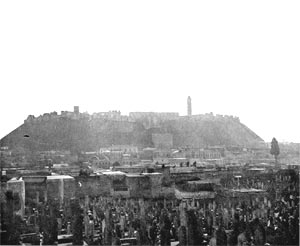
|
CHAPTER I
ALEPPO TO TELL AHMAR
Feb. 3—Feb. 21
A SMALL crowd had gathered round one of the booths in the saddlery bazaar,
and sounds of controversy echoed down the vaulted ways. I love to follow the
tortuous arts of Oriental commerce, and moreover at the end of the dark gallery
the February sun was shining upon the steep mound of the citadel; therefore I
turned into the saddlers' street, for I had no other business that afternoon
than to find the road back into Asia, back into the familiar enchantment of the
East. The group of men round the booth swayed and parted, and out of it
shouldered the tall figure of Fattûh.
[ Illustrations opposite p.10 ]
"May God be exalted!" said he, stopping
short as he caught sight of me. "It is well that your Excellency should witness
the dealings of the saddlers of Aleppo. Without shame are they. Thirty years and
more have I lived in Aleppo, and until this day no man has asked me to give two
piastres for a hank of string." He cast a withering glance, charged with
concentrated animosity, upon the long-robed figure that stood, string in hand,
upon the counter.
"Allah!" said I warily, for I did not wish to parade my
ignorance of the market value of string. "Two piastres?"
"It is good
string," said the saddler ingratiatingly, holding out what looked like a tangled
bundle of black wool.
"Eh wah!" intervened a friend. "'Abdullah sells nought
but the best string."
I took a seat upon a corner of the counter and Fattûh / p.2 / came slowly back, shaking his head mournfully, as one who
recognizes but cannot amend the shortcomings of mankind. The whole company closed
in behind him, anxious to witness the upshot of the important transaction upon
which we were engaged. On the outskirts stood one of my muleteers like a man
plunged in grief; even the donkey beside him — a recent purchase, though
acquired at what cost of eloquence only Fattûh can know — drooped its ears. It
was plain that we were to be mulcted of a farthing over that hank of
string.
Fattûh drew a cotton bag out of his capacious trousers.
"Take the
mother of eight," said he, extracting a small coin.
"He gives you the mother of
eight," whispered one of the company encouragingly to the saddler.
"By God
and the Prophet, it cost me more! Wallah, it did, oh my uncle!" expostulated the
saddler, enforcing his argument with imaginary bonds of kinship.
Fattûh threw
up his eyes to the vault as though he would search heaven for a sign to confound
this impious statement; with averted head he gazed hopelessly down the long
alley. But the vault was dumb, and in all the bazaar there was no promise of
Divine vengeance. A man touched his elbow.
"Oh father," he said, "give him
the mother of ten."
The lines of resolution deepend in Fattûh's face. "Sir,
we would finish!" he cried, and fumbled once more in the cotton bag. The
suspense was over; satisfaction beamed from the countenances of the
bystanders.
"Take it, oh father, take it!" said they, nudging the saddler
into recognition of his unexampled opportunity.
The hank of string was handed
over to Hâjj 'Amr, who packed it gloomily into the donkey's saddle bags, already
crammed to overflowing with the miscellaneous objects essential to any
well-ordered caravan on a long journey. Fattûh and Hâjj 'Amr had been shopping
since dawn, and it was now close upon sunset.
I climbed down from the
counter. "With your leave," said I, saluting the saddler.
/ ALEPPO p.3 /
"Go in peace," he returned amicably. "And if you want more string Fattûh
knows where to get it. He always deals with me."
The crowd melted back to its
avocations, if it had any, and the excitement caused by our commercial dealings
died away.
"Oh Fattûh," said I, as we strolled down the bazaar with the
donkey. "There is great labour in buying all we need."
Fattûh mopped his brow
with a red handkerchief. "And the outlay!" he sighed. "But we got that string
cheap." And with this he settled his tarbush more jauntily, kicked the donkey,
and "Yallah, father!" said he.
If there be a better gate to Asia than Aleppo,
I do not know it. A virile population, a splendid architecture, the quickening
sense of a fine Arab tradition have combined to give the town an individuality
sharply cut, and more than any other Syrian city she seems instinct with an
inherent vitality. The princes who drew the line of massive masonry about her
flanks and led her armies against the emperors of the West, the merchants who
gathered the wealth of inner Asia into her bazaars and bartered it against the
riches of the Levant Company have handed down the spirit of enterprise to the
latest of her sons. They drive her caravans south to Baghdâd, and east to Vân,
and north to Konia, and in the remotest cities of the Turkish empire I have
seldom failed to find a native of Aleppo eager to provide me with a local
delicacy and to gossip over local politics. "Here is one who heard we were from
Aleppo," says Fattûh with an affected indifference. "His brother lives in the
next street to mine, and he has brought your Excellency some apples. But they
are not like the apples of Aleppo." Then we exchange a greeting warm with
fellow-citizenship and the apples are flavoured with good-will, even if they
cannot be expected to vie with the fruit of our own countryside.
It was at
Aleppo that I made acquaintance with the Turkey which had come into being on
July 24, 1908. Even among those whose sympathies were deeply engaged on behalf
of the new order, there were not many Europeans who, in / p.4 / January 1909, had any clue to public opinion outside Constantinople and
Salonica. The events of the six stirring months that had just elapsed had yet to
be heard and apprehended, and no sooner had I landed in Beyrout than I began to
shed European formulas and to look for the Asiatic value of the great catchwords
of revolution. In Aleppo, sitting at the feet of many masters, who ranged down
all the social grades from the high official to the humblest labourer for hire,
I learnt something of the hopes and fears, the satisfaction, the bewilderment,
and the indifferent of Asia. The populace had shared in the outburst of
enthusiasm which had greeted the granting of the constitution — a moment of
unbridled expectation when, in the brief transport of universal benevolence, it
seemed as if the age-long problems of the Turkish empire had been solved with a
stroke of the pen; they had journeyed back from that utopia to find that human
nature remained much as it had been before. The public mind was unhinged; men
were obsessed with a sense of change, perplexed because change was slow to come,
and alarmed lest it should spring upon them unawares. The relaxation of the rule
of fear had worked in certain directions with immediate effect, but not
invariably to the increase of security. True, there was a definite gain of
personal liberty. The spies had disappeared from official quarters, and with
them the exiles, who had been condemned by 'Abdu'l Hamîd, on known or unknown
pretexts, to languish helplessly in the provincial capitals. Everywhere a daily
press had sprung into existence and foreign books and papers passed unhindered
through the post. The childish and exasperating restrictions with which the
Sultan had fettered his Christian subjects had fallen away. The Armenians were
no longer tied to the spot whereon they dwelt; they could, and did, travel where
they pleased. The nâmûsîyeh, the identification certificate, had received the
annual government stamp without delay, and without need of bribes. In every
company, Christian and Moslem, tongues were unloosed in outspoken criticism of
official dealings, but it was extremely rare to find in these freely vented
opinions anything of a / ALEPPO p.5 / constructive
nature. The government was still, to the bulk of the population, a higher power,
disconnected from those upon whom it exercised its will. You might complain of
its lack of understanding just as you cursed the hailstorm that destroyed your
crops, but you were in no way answerable for it, nor would you attempt to
control or advise it, any more than you would offer advice to the hail cloud.
Many a time have I searched for some trace of the Anglo-Saxon acceptance of a
common responsibility in the problems that beset the State, a sense the germs of
which exist in the Turkish village community and in the tribal system of the
Arab and the Kurd; it never went beyond an embryonic application to small local
matters, and the answer I received resembled, mutatis mutandis, that of
Fattûh when I questioned him as to the part he had played in the recent general
election. "Your Excellency knows that I am a carriage-driver, what have I to do
with government? But I can tell you that the new government is no better than
the old. Look now at Aleppo; have we a juster law? wallah, no!"
In some
respects they had indeed a yet more laggard justice than in "the days of
tyranny" — so we spoke of the years that were past — or perhaps it would be
truer to say a yet more laggard administration. The dislocation of the old order was a fact considerably more salient than the substitution for it of another
system. The officials shared to the full the general sense of impermanence that
is inevitable to revolution, however soberly it may be conducted; they were
uncertain of the limits of their own authority, and as far as possible each one
would shuffle out of definite action lest it might prove that he had overstepped
the mark. In the old days a person of influence would occasionally rectify by
processes superlegal a miscarriage of the law; the miscarriages continued, but
intervention was curtailed by doubts and misgivings. The spies had been in part
replaced by practically irresponsible power. How far the supremacy of the local
committees extended it was difficult to judge, nor would a conclusion based upon
evidence from one province / p. 6 / have been applicable to
another; but my impression is that nowhere were they of much account, and that
the further the district was removed from the coast, that is, from contact with
the European centres of the new movement, the less influential did they become. Possibly in the remoter provinces the local committee was itself reactionary, as I have heard it affirmed, or at best an object of ridicule, but in Syria, at any rate, the committees existed in more than the name. Their inner organization was at that time secret, as was the organization of the parent society. They had taken form at the moment when the constitution was proclaimed, and had undergone a subsequent reconstruction at the hands of delegates from Salonica, who were sent to instruct them in their duties. I came across one case where these delegates, having been unwisely selected, left the committee less well qualified to cope with local conditions than they found it, but usually they discharged their functions with discretion. The committees opened clubs of Union and Progress, the members of which numbered in the bigger towns several hundreds. The club of Aleppo was a flourishing institution lodged in a large bare room in the centre of the town. It offered no luxuries to the members, military and
civilian, who gathered round its tables of an evening but it supplied them with a good stock of newspapers, which they read gravely under the shadow of a life-sized portrait of Midhat Pasha, the hero and the victim of the first constitution. The night of my visit the newly formed sub-committee for commerce
was holding its first deliberations on a subject which is of the utmost importance to the prosperity of Aleppo: the railway connection with the port of Alexandretta. To this discussion I was admitted, but the proceedings after I had taken my seat at the board were of an emotional rather than of a practical character, and I left with cries of "Yasha Inghilterra!" ("Long live England!")
in my ears. I carried away with me the impression that whatever might be the
future scope of its activities, the committee could not fail, in these early days, to be of some educational value. It brought men together to debate on matters that touched the/ ALEPPO p. 7 / common good and invited them to bear a part in their promotion. The controlling authority of the executive body was of much more questionable advantage. Its members, whose names were kept profoundly secret, were supposed to keep watch over the conduct of affairs and to forward reports to the central committee: I say supposed, because I have no means of knowing whether they actually carried out what they stated to be their duties. They justified their position by declaring that it
was a temporary expedient which would lapse as soon as the leaders of the new
movement were assured of official loyalty to the constitution, and arbitary as
their functions may appear it would have been impossible to assert that Asiatic
Turkey was fit to run without leading-strings. But I do not believe that the
enterprise of the committees was sufficient to hamper a strong governor; and so
far as my observation went, the welfare of each province depended, and must
depend for many a year to come, upon the rectitude and the determination of the
man who is placed in authority over it.
Underlying all Turkish politics are the closely interwoven problems of race and religion, which had been stirred to fresh activity by exuberant promises. Fraternity and equality are dangerous
words to scatter broadcast across an empire composed of many nationalities and
controlled by a dominant race. Under conditions such as these equality in its
most rigid sense can scarcely be said to exist, while fraternity is complicated by the fact that the ruling race professes Islâm, whereas many of the subordinate elements are Christian. The Christian population of Aleppo was bitterly disheartened at having failed to return one of their own creed out of
the six deputies who represent the vilayet. I met, in the house of a common friend, a distinguished member of the Christian community who threw a great deal of light on this subject. He began by observing that even in the vilayet of Beyrout, though so large a proportion of the inhabitants are Christian, the appointment of a non-Moslem governor would be impossible; so much, he said, for the boast of equality. This is, of course, undeniable, / p.8 /
though in the central government, where they are not brought into direct contact
with a Moslem population, Christians are admitted to the highest office. He complained that when the Christians of Aleppo had urged that they should be permitted to return a representative to the Chamber, the Moslems had given them no assistance. "They replied," interposed our host, "that it was all one, since Christians and Moslems are merged in Ottoman." I turned to my original interlocutor and inquired whether the various communions had agreed upon a
common candidate.
"No," he answered with some heat. "They brought forward as many candidates as there are sects. Thus it is in our unhappy country; even the Christians are not brothers, and one church will not trust the other."
I said that this regrettable want of confidence was not confined to Turkey, and asked whether, if they could have commanded a united vote, they would have carried their candidate. He admitted with reluctance that he thought it would have been possible, and this view was confirmed by an independent witness who said that a Christian candidate, carefully chosen and well supported, would have received in addition the Jewish vote, since that community was too small to return a
separate representative.
As for administrative reform, it hangs upon the
urgent problem of finance. From men who are overworked and underpaid neither
efficiency nor honesty can be expected, but to increase their number or their salary is an expensive business, and money is not to be had. How small are the local resources may be judged from the fact that Aleppo, a town of at least 120,000 inhabitants, possesses a municipal income of from £3,000 to £4,000 a
year. Judges who enjoy an annual salary of from £60 to £90 are not likely to prove incorruptible, and it is difficult to see how a mounted policeman can support existence on less than £12 a year, though one of my zaptiehs assured me that the pay was sufficient if it had been regular. In the vilayet of Aleppo and the mutesarriflik of Deir all the zaptiehs who accompanied me had received the arrears due to them as well as / ALEPPO p.9 / their weekly wage, but this fortunate condition did not extend to other parts of the empire.
The plain man of Aleppo did not trouble his head with fiscal
problems; he judged the new government by immediate results and found it wanting. I rode one sunny afternoon with the boy, Fattûh's brother-in-law, who was to accompany us on our journey, to the spring of 'Ain Tell, a mile or two north of the town. Jûsef--his name, as Fattûh was careful to point out, is French: "I thought your Excellency knew French," he said severely, in answer to my tactless inquiry-- Jûsef conducted me across wet meadows, where in spring the citizens of Aleppo take the air, and past a small mound, no doubt artificial, a relic perhaps of the constructions of Seif ed Dauleh, whose palace once occupied these fields. Close to the spring stands a mill with a pair of stone lions
carved on the slab above the door, the heraldic supporters of some prince of Aleppo. They had been dug out of the mound together with a fine basalt door, like those which are found among the fourth and fifth century ruins in the neighbouring hills; the miller dusted it with his sleeve and observed that it was an antîca. A party of dyers, who were engaged in spreading their striped
cotton cloths upon the sward, did me the honours of their drying-ground — merry
fellows they were, the typical sturdy Christians of Aleppo, who hold their own
with their Moslem brothers and reckon little of distinctions of creed.
"Christian and Moslem," said one, "see how we labour! If the
constitution were worth anything, the poor would not work for such small rewards."
"At any rate," said I, "you got your nâmûsîyeh cheaper this
year."
"Eh true!" he replied, "but who can tell how long that will
last?"
"Please God, it will endure," said I.
"Please God," he answered. "But we should have been better satisfied to see the soldiers govern. A strong
hand we need here in Aleppo, that the poor may enjoy the fruits of their toil."
/ p.10 /
"Eh wah!" said another, "and a government that we know."
Between them they
had summed up popular opinion, which is ever blind to the difficulties of reform
and impatient because progress is necessarily slow footed.
We passed on our
return the tekîyeh of Abu Bekr, a beautiful Mamlûk shrine with cypresses in its courtyard, which lift their black spires proudly over that treeless land. The
brother of the hereditary sheikh showed me the mosque; it contains an exquisite
mihrâb of laced stone work, and windows that are protected by carved wooden
shutters and filled with old coloured glass. Near the mosque is the square hall
of a bath, now fallen into disrepair. Four pendentives convert the square into
an octagon, and eight more hold the circle of the dome — as fine a piece of
massive construction as you would wish to see. The sheikh and his family
occupied some small adjoining rooms, and the young wife of my guide made me
welcome with smiles and lemon sherbet. From the deep embrasure of her window I
looked out upon Aleppo citadel and congratulated her upon her secluded house set
in the thickness of ancient walls.
"Yes," she replied, eagerly detailing the
benefits of providence, "and we have a carpet for winter time, and there is no
mother-in-law."
Aleppo is the Greek Beroea, but the town must have played a
part in the earlier civilizations of North Syria. It lies midway between two
Hittite capitals, Carchemish on the Euphrates, and Cadesh on the Orontes, in the
heart of a fertile country strewn with mounds and with modern mud-built
villages. The chief town of this district was Chalcis, the modern Kinnesrîn, a
day's journey to the south of Aleppo, but with the development of the great
Seleucid trade-route between Seleucia on the Trigis and Antioch on the Orontes,
which Strabo describes as passing through Hierapolis, Aleppo, being on the
direct line to Antioch, must have gained in importance, and it was perhaps for
this reason that the little Syrian village saw the Seleucid foundations of
Beroea. The Arabic name, Haleb, retains a reminis-

|
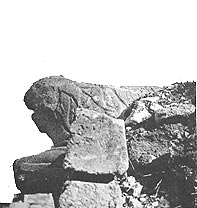 CITADEL. |
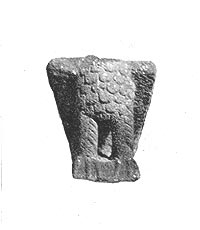 FRENCH CONSULATE. |
[ Illustrations opposite p.11 ]
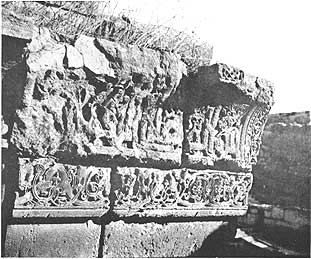
|
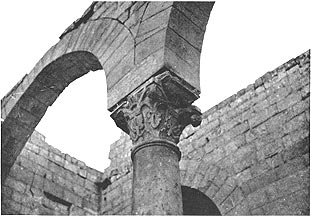
|
/ ALEPPO p.11 / cence of the original local appellation, which never slipped out of memory and finally conquered the Greek Beroea. Mohammadan tradition recognizes the fact that Haleb was the ancient name of the city in the foolish tale which connects it with the cows of Abraham, the root of the word Haleb being the verb signifying to milk, and the Emperor Julian knew that Beroea was the same as Chaleb. Aleppo is not without evidences of a remote antiquity. Every archaeologist in turn has tried his hand at the half obliterated Hittite inscription which is built, upside down, into the walls of the mosque of Kikân near the Antioch gate; among the ruins of the citadel are two roughly worked Hittite lions (Fig. 2; Mr. Hogarth was the first to identify them), and I found in the French Consulate a headless eagle carved in basalt which belongs to the same period (Fig. 3). The steep escarpment of the castle mound is akin to the ancient fortified sites of northern Mesopotamia. Julian mentions the acropolis of Beroea. It was protected in a later age by a revetment of stone slabs, most of which were stripped away by Tîmûr Leng when he overwhelmed the town in 1401 and laid it in ruins. I know of only one building in Aleppo the origin of which can be attributed with certainty to the pre-Mohammadan period, the Jâmi' el Helâwîyeh near the Great Mosque (Fig. 6). It has been completely rebuilt; the present dome, resting on pendentives, with a tambour broken by six windows, belongs to one of the later reconstructions, but the beautiful acanthus capitals must be ascribed to the fifth century on account of their likeness to the capitals in the church of St. Simeon Stylites, a day's journey north-west of Aleppo. The great school of architecture which they represent affected the builders of Islâm through many a subsequent age, and you will find the Mamlûks still flinging the leaves of the wind-blown acanthus about the capitals in their mosques. In the tenth century Aleppo was the chief city of the Hamdânid prince Seif ed Dauleh, a notable patron of the arts. It was he who built the south gate in the walls, the Bâb Kinnesrîn, and rebuilt the Antioch Gate after its destruction by Nicephorus Phocas; he repaired the citadel, / p.12 / set the shrine of Hussein upon the hill-side west of the town, and erected his own splendid dwelling outside the walls to the north. His palace was ravaged before his death, his gates and mosques have been rebuilt, and there remains for the period before Saladin little or nothing but the mosque inside the citadel, built in 1160 by Nûr ed Dîn, the greatest of the Syrian atabegs, and the Jâmi' esh Shaibîyeh near the Antioch Gate, which, in spite of its ruined condition, is one of the loveliest monuments of the art of Islâm in the whole town of Aleppo (Fig. 4).1
---------------------------
1 It is dated in the year 545
A.H., i.e. A.D. 1150.
---------------------------
Along the top of the wall and carried uninterruptedly round the square minaret, runs a Cufic inscription, cut in a cavetto moulding. Below it is a band of interlacing rinceaux, unsurpassed in boldness and freedom of design, and above it a heavy cymatium, borne on modillions and adorned with rinceaux. The classical outline of the cornice, together with the exquisite Oriental decoration, give it a singular hybrid beauty. This mosque apart, the finest buildings are due to the Ayyûbids, and chiefly to El Malik ez Zâhir, the son of Saladin, who ruled in Aleppo at the end of the twelfth century. Beyond the walls to the south of the city, in the quarter of Firdaus, the descendants of Saladin held their court, and though their palaces have disappeared — how much more we should know of Mohammadan architecture if each successive conqueror had not ruined the house of his predecessor! — the suburb is still resplendent with mosques and tombs. Here stands the Medreseh of El Malik ez Zâhir, with an arcade borne on capitals that retain a reminiscence of classical form though they are hung with a garland of leaves that are closer to the Sasanian than to the Greek (Fig.5).2
---------------------------
2 The Persian influence had
probably filtered through Egypt, for similar leaf motives are to be found in
Cairo, for example in a fine bit of woodwork in the Museum: Herz Bey,
Catalogue Raisonné, fig. 24. The prototype must be looked for in the
plaster decorations of Ibn Tûlûn.
---------------------------
Near it is the mosque of Firdaus built by the king's widow when she was regent for her son. Over the mihrâb of this mosque is a bold entrelac decoration which is to be found also in the shrine of Hussein, a building that
[ Illustrations opposite p.12 ]
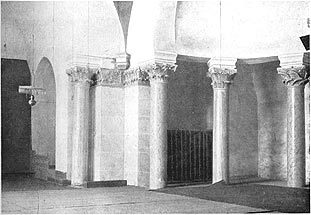
|
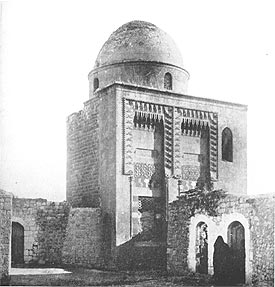
|
[ Illustrations opposite p.13 ]
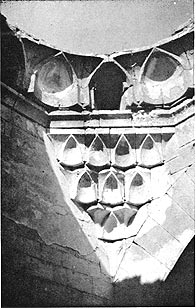
|
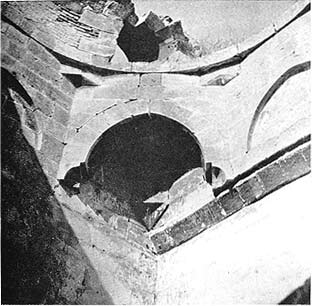
|
/ ALEPPO p.13 /
owes its present form to El Malik ez Zahir.1
---------------------------
1 M. Saladin believes this
entrelac to be of Damascene origin. Manuel d'Art Musulman, i. p.
115.
---------------------------
The mosque of Es Sâlihîn shelters a gigantic footprint of Abraham, and about
it lie the tombs of the pious who sought a resting-place near the site
sanctified by the patriarch — tombstones worthy of a museum, carved with Cufic
inscriptions and with vine scrolls and bunches of grapes. And falling now into
unheeded decay are other memorials of the dead, their walls covered with
delicate tracery and their windows filled with an exquisite lacework of stone
(Fig.7). They were great builders these princes of Islâm, Ayyûbid and Mamlûk,
and in nothing greater than in their mastery of structural difficulties. The
problem of the dome, its thrust and its setting over a square substructure,
received from them every possible solution; they bent the solid stone into airy
forms of infinite variety (Figs. 8 and 9). Their splendid masonry satisfied the
eye as does the wall of a Greek temple, and none knew better than they the value
of discreet decoration. The restraint and beauty of such treatment of the wall
surface as is to be found in the Khân el Wazîr (Fig. 10) or the Khân es Sabûn
(Fig. 11) bear witness to a master hand. The grace and ordered symmetry of these
façades are as devoid of monotony as are the palace walls of the early Venetian
renaissance, to which they are closely related, and here as in Venice the
crowning beauty of colour is added to that of form and proportion. But it is
colour of the sun's own making; the sharp black outline of a window opening, the
half tones of a carved panel lying upon the smooth brightness of the masonry
soberly enhanced by the occasional use of a darker stone, either in courses of
in alternate voussoirs. If you are so fortunate as to have many friends in
Aleppo, you will find that the domestic archtecture is no less admirable, and
drinking your coffee under panelled ceilings rich with dull golds and soft deep
reds, you will magnify once again the genius of the artificers of Asia.
The
walls and gates of the city, though they are not so well preserved as those of
Diyârbekr, are fine examples of / p.14 / mediaeval fortification.
To the north a prosperous quarter lies beyond the older circuit and the heraldic
lions of the Mamlûks look down upon streets crowded with traffic. Armorial
bearings played a large part in the decorative scheme of the Mohammadan
builders. The type characteristic of Aleppo is a disk projecting slightly from
the wall, carved with a cup from the base of which spring a pair of leaves. Upon
the cup there are strange signs which are said to have been imitated from
Egyptian hieroglyphs, a motive introduced by the Mamlûks; but I have noticed a
variety of coats of the same period, such as the whorl which fills the disk upon
the Bâb el Makâm, and the pair of upright pot-hooks, set back to back, upon the
Jâmi' el Makâmât in the Firdaus quarter. These disks, together with bands of
inscriptions, are the sole ornaments placed upon the city gates.
The sombre
splendour of the architecture of Aleppo is displayed nowhere better than in the
Bîmâristân of El Malik ez Zâhir, which was built as a place of confinement for
criminal lunatics and is still used for that purpose. The central court
terminates at the southern end in the lîwân of a mosque covered with an oval
dome; before it lies the ceremonial water-tank, if any one should have the heart
to wash or pray in that house of despair. A door from the court leads into a
stone corridor, out of which open rectangular stone chambers with massive walls
rising to a great height, and carrying round and oval domes. Through narrow
window slits, feeble shafts of light fall into the dank well beneath and shiver
through the iron bars that close the cells of the lunatics. They sit more like
beasts than men, loaded with chains in their dark cages, and glower at each
other through the bars; and one was sick and moaned upon his wisp of straw, and
one rattled his chains and clawed at the bars as though he would cry for mercy,
but had forgotten human speech. "They do not often recover," said the gaoler,
gazing indifferently into the sick man's cell, and I wondered in my heart
whether there were any terms in which to reckon up the misery that had
accumulated for generations under El Malik ez Zâhir's domes.
[ Illustrations opposite p.14 ]
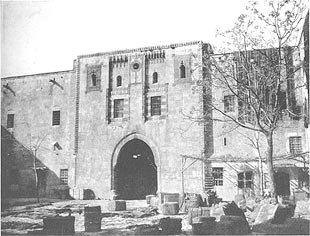
|
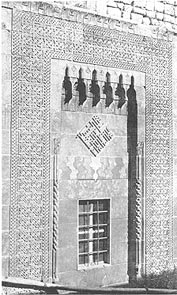
|
[ Illustrations opposite p.15 ]
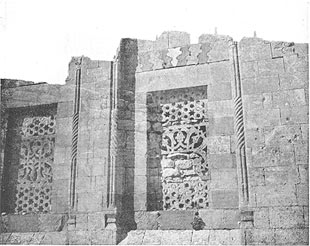
|
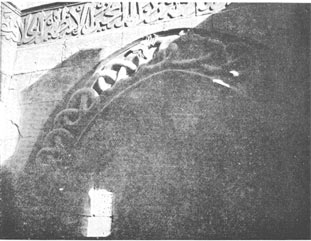
|
/ ALEPPO p.15 /
Like the numismatic emblem of a city goddess, Aleppo wears a towered crown. The citadel lies immediately to the east of the bazaars. A masonry bridge
resting on tall narrow arches spans the moat between a crenelated outpost and
the great square block of the inner gatehouse. Through a worked iron door, dated
in the reign of El Malik ez Zâhir, you pass into a vaulted corridor which turns
at right angles under an arch decorated with interlaced dragons (Fig. 13), and
ends at another arched doorway on which stand the leopards of Sultan Baybars,
who rebuilt the castle in the thirteenth century. Above the entrance is a
columned hall, grass-grown and ruined; passages lead down from it into vaulted
chambers which would seem to have been repaired after Tîmûr had sacked Aleppo.
Some of the blocks used in the walls here are Jewish tombstones dated by Hebrew
inscriptions in the thirteenth century, and since it is scarcely possible that
Baybars should have desecrated a cemetery of his own day, they must indicate a
later period of reconstruction. The garrison was supplied with water from a well
eighty metres deep which lies near the northern edge of the castle mound. Besides
the well-hole, a stair goes down to the water level, near which point vaulted
passages branch out to right and left. Tradition says that the whole mound is
raised upon a substructure of masonry, but tradition is always ready with such
tales, and the only inscription in the passages near the well is Cufic. At the
northern limit of the enclosure stands a high square tower, up which, if you
would know Aleppo, you must climb. From the muedhdhin's gallery the town lies
revealed, a wide expanse of flat roof covering the bazaars, broken by dome and
minaret, by the narrow clefts of streets and the courts of mosque and khân. The
cypresses of Abu Bekr stand sentinel to the north; from that direction Tîmûr
entered through the Bâb el Hadîd. In the low ground beyond the Antioch Gate, the
armies of the Crusaders lay encamped; the railway, an invader more powerful than
Baldwin, holds it now. Turn to the east, and as far as the eye can see, stretch
rolling uplands, the granary of North Syria, and across them wind the caravan
tracks that lead into inner Asia. There through the waste / p.16 /
flows the Euphrates — you might almost from the tower catch the glint of its
waters, so near to the western sea does its channel approach here.
I have
never come to know an Oriental city without finding that it possesses a
distinctive personality much more strongly accentuated than is usually the case
in Europe, and this is essentially true of the Syrian towns. To compare
Damascus, for example, with Aleppo, would be to set side by side two different
conceptions of civilization. Damascus is the capital of the desert, Aleppo of
the fertile plain. Damascus is the city of the Arab tribes who conquered her and
set their stamp upon her; Aleppo, standing astride the trade routes of northern
Mesopotamia, is a city of merchants quick to defend the wealth that they had
gathered afar. So I read the history that is written upon her walls and
impressed deep into the character of her adventurous sons.
At Aleppo the
current of the imagination is tributary to the Euphrates. With Xenophon, with
Julian, with all the armies captained by a dream of empire that dashed and broke
against the Ancient East, the thoughts go marching down to the river which was
the most famous of all frontier lines. So we turned east, and on a warm and
misty February morning we passed under the cypresses of Abu Bekr and took the
road to Hierapolis. It was a world of mud through which we journeyed, for the
rains had been heavy, and occasionally a shower fell across our path; but rain
and mud can neither damp nor clog the spirit of those who are once more upon the
road, with faces turned towards the east. The corn was beginning to sprout and
there were signs too of another crop, that of the locusts which had swarmed
across the Euphrates the year before, and after ravaging the fields had laid
their eggs in the shallow earth that lies upon the rocky crest of the ridges
between cornland and cornland. Whenever the road climbed up to these low
eminences we found a family of peasants engaged, in a desultory fashion, in
digging out the eggs from among the stones. Where they lay the ground was pitted
like a face scourged with smallpox, but for every square yard cleared a square
mile was left undisturbed, and / BAB p.17 / the peasants
worked for the immediate small reward which the government paid for each load of
eggs, and not with any hope of averting the plague that ultimately overwhelmed
their crops. It comes and goes, for what reason no man can tell, lasting in a
given district over a term of lean years, and disappearing as unaccountably as
it came: perhaps a storm of rain kills the larvae as they are hatching out,
perhaps the breeding season is unfavourable — God knows, said Hâjj 'Alî, the
zaptieh who accompanied me. The country is set thick with villages, of which
Kiepert marks not the tenth part — and even those not always rightly placed. We
passed his Sheikh Najar, and at Sheikh Ziyâd I went up to see the ziyârah, the
little shrine upon the hill-top, but found there nothing but a small chamber
containing the usual clay tomb. We left Serbes on the right — it was hidden
behind a ridge — and took a track that passed through the village of Shammar.
Not infrequently there were old rock-cut cisterns among the fields and round the
mounds whereon villages had once stood. At Tell el Hâl, five hours from Aleppo,
a modern village lies below the mound, and by the roadside I saw part of the
shaft of a column, with a moulded base, while several more fragments of columns
were set up as tombstones in the graveyard. An hour before we reached Bâb we
caught sight of the high minaret of the ziyârah above it. It is a flourishing
little place with a bazaar and several khans, in one of which I lodged. The
heavy rain-clouds that had hung about us all day were closing down as evening
approached, but I had time to climb the steep hill to the west of the village,
where a cluster of houses surrounds the ziyârah of Nebî Hâshil — so I heard the
name, but Abu'l Fidâ calls it the Mashhad of 'Akil ibn Abî Tâlib, brother of the
Khalif 'Alî1
---------------------------
1 Ed. Reinaud, p. 267. He wrote
in A.D. 1321.
---------------------------
— an old shrine of which the lower part of the walls is built of rusticated stones. The tomb itself was closed, but I went ot the top of the minaret and had a fine view of the shallow fruitful valley of the Deheb, which, taking its source near Bâb and the more northerly Tell Batnân, runs down to the salt marshes at the foot of Jebel / p.18 / el Hass. Across the valley there is a notable big mound with a village at its foot, the Buzâ'â of the Arab geographers, "smaller than a town and larger than a village," said Ibn Jubeir in the twelfth century. The ancient Bathnae where Julian rested under "a pleasant grove of cypress trees" is represented by Buzâ'â and its "gate" Bâb. He compares its gardens with those of Daphne, the famous sanctuary of Apollo near Antioch, and though the gardens and cypresses have been replaced by cornfields, it is still regarded by the inhabitants of Aleppo as an agreeable and healthy resort during the hot months of summer. Perhaps we may carry back its history yet earlier and look here for the palace of Belesys, the Persian governor of Syria, at the source of the river Dardes, which Xenophon describes as having "a large and beautiful garden containing all that the seasons produce."1
---------------------------
1Anabasis, Bk. I. ch. iv,
10.
---------------------------
Cyrus laid it waste and burned the palace, after which he marched three days to Thapsacus on the Euphrates; but the Arab geographers place Bâlis (which some have conjectured to have occupied the site of the Persian palace) two days from Aleppo, and the position of Thapsacus has not been determined with any certainty. If it stood at Dibseh, as Moritz surmises,2
---------------------------
2 Zur antiken Topographie der Palmyrene, p. 31.
---------------------------
Cyrus could well have reached it in three marches from Bâb, and I am inclined to think that Xenophon's account identifies the satrap's pleasaunce with the garden of Bathnae. In Kiepert's map the relative distances between Aleppo and Bâb and Bâb and Manbij are not correct. I rode the two stages in almost exactly the same time (seven and a quarter hours), and the caravan took nine hours each day, whereas the map would have the march to Manbij a good two hours longer than the march to Bâb.3
---------------------------
3 Mr. Hogarth also noticed that
Bâb is marked out of its true place: Annual of the British School at
Athens, XIV. p. 185.
---------------------------
A stormy wind, bringing with it splashes of rain, swept us next morning over
the wet uplands. About an hour from Bâb we were joined by a Circassian wrapped
in a thick black felt cloak, which, with the white woollen hood over an
/ HIERAPOLIS p.19 / astrachan cap, skirted coat with
cartridges ranged across the breast, and high riding-boots, is the invariable
costume of these emigrants from the north. His name was Mahmûd Aghâ. His father
had left the Caucasus after the Russians took the country and had gone with all
his people to Roumelia, where they settled down and built houses. And then the
Russians seized that land also, and again they left all and came to Manbij, and
the Sultan gave them fields on his own estates. "But if the Russians were to
come here too," he concluded, with the anxious air of one who faces an
ever-present danger, "God knows where we should go."
"Their frontier is far,"
said I reassuringly.
"Please God," said he.
I asked him about the recent
elections and found that he took a lively interest in the politics of the day.
He knew the names of the deputies who had been returned for the vilayet of
Aleppo, and said that a thousand people had given their votes in the Manbij
district, though there should have been many more if all had been on the
register. But they would not trouble to have their names placed upon
it.
"Wallah, no," observed Hâjj 'Alî. "Do you think that the fellahin of all
these villages wish to vote? If they knew that their name was written down by
the government, they would take to their heels and flee into the desert, leaving
all that they have. So great would be their fear."
This was a new view of the duties and privileges of citizenship, and once more I had to shift my ground and
look at representative institutions through the eyes of the Syrian
peasant.
"Then none of the Arab vote?" I asked, when I had accomplished this
revolution of the mind. The Arab are the Bedouin.
"God forbid!" replied Hâjj
'Alî. "Where is Aleppo and where their dwelling-place!"
"We are all equal now
before the law," said Mahmûd Aghâ inconsequently (but he was thinking of
townsfolk, not of the Arab), "and all will be given an equal justice. We shall
not / p.20 / wait for months at the door of the serâyah before we
are given a hearing — and then only with bribes."
"I have heard that all are
equal," said I, "and that Christian and Moslem will serve together in the army.
What think you?"
"Without doubt the Christians may serve," he answered, "but
they cannot command."
In three and a half hours we reached the village of
Arîmeh, where there are two Roman milestones that have been copied by Mr.
Hogarth. He dates them A.D. 197, in which year the Emperor Septimius Severus,
whose name is inscribed upon them, probably completed the road. I suspect that
it followed the Seleucid trade route mentioned by Strabo. There are not more
than a dozen houses at Arîmeh, but the ancient settlement was more important.
Cut stones lie about the modern hovels, and behind them are ruined foundations,
among which we found the fragment of a bas-relief, a pair of shod feet and
another foot beside them: I did not judge it to be earlier than the Roman
period. A large stone block built into the wall of one of the courtyards bore a
much worn foundation inscription of El Malik ez Zâhir, his name and the words
"he built it" being alone decipherable. We rode on to Hierapolis across a hollow
plain, all cultivated, the sacred domain of the Syrian goddess "whom some call
nature herself, the cause that produces the seed of all things."1
---------------------------
1Plutarch: In
Crass.
---------------------------
When we passed over the ground it was still a chiflik, the private property of 'Abdu'l Hamîd, wrested by him bit by bit during the last thirty years from its owners, the half-settle Arabs. With all the rest of his landed estates it was appropriated after his deposition in April by the State, and if it is put up for sale there will be no lack of customers in Aleppo, for the merchants are eager to lay field to field, and I have heard them complain of the difficulty of buying land near home, since all was held by the Sultan. We rode between the air-holes of underground canals, of which there were a great number bringing water to Hierapolis. The old line of / HIERAPOLIS p.21 / the city walls is clearly marked, though the Circassian colony, which grows in numbers and prosperity in spite of the antagonism of the neighbouring Arabs, is rapidly digging out the stones and using them in the construction of houses. Just within the walls, as we approached from the west, is a large pond, surrounded by masonry, the remains of the stairs by which the worshippers descended into the pool of Atargatis that they might swim to the altar in its midst. Lucian declares that the pool wherein were kept the sacred fish was over 200 cubits deep, but his informants must have exaggerated, inasmuch as Pocock, who visited Hierapolis in 1787, mentions that the pool was dry, and does not speak of so remarkable a hole as Lucian's estimate would imply. Maundrell, who saw it in 1699, describes it as a deep pit containing a little water, but choked by the walls and columns of great buildings that had stood all about it. East of the pool there is a modern mosque erected by 'Abdu'l Hamîd on the site of a foundation of El Malik ez Zâhir. Nothing remained of the earlier building, I was told, but a ruined minaret,1
---------------------------
which has now gone. In the sahn, the court, I saw three inscriptions of El Malik ez Zâhir which
had belonged to his mosque. Below the pavement of the sahn, said the guardian of
the mosque, a second pavement had been found which he believed to have been that
of a Christian church; there were one or two columns lying about here, and an
acanthus capital which was certainly pre-Mohammadan and probably pre-Christian.
Manbij was at one time a bishopric; the earlier travellers mention several
ruined churches which have now vanished, and Ibn Khurdâdhbeh, one of the first
of the Arab geographers, remarks that "there is no wooden building fairer than
the church at Manbij, for it has arches of jujube wood"2
---------------------------
— an observation which is repeated with wearisome iteration by many of his successors.
The pool and the mosque stand for the two periods of former splendour, the
pagan and the Mohammadan. Bam- / p.22 / byce — to give it the
classicized form of its ancient local name1
---------------------------
— must have been a
shrine of some importance when the Seleucids rechristened it Hierapolis, but, as
at Aleppo, the older word was never forgotten, and Strabo in the first century
calls it by both names. His account is suggestive of the conditions that prevailed in the Seleucid
empire. "The road for merchants," says he, "going from Syria to Seleucia and
Babylon, lies through the country of the Scenitae and through the desert
belonging to their territory. The Euphrates is crossed in the latitude of
Anthemusia, a place in Mesopotamia.2
---------------------------
Above the river, at a distance of four schoeni, is Bambyce, where the Syrian
goddess Atargatis is worshipped. After crossing the river the road runs through
a desert country on the borders of Babylonia, to Scenae. From the passage across
the river to Scenae is a journey of five-and-twenty days. There are on the road
owners of camels who keep resting-places which are well supplied with water from
cisterns, or transported from a distance. The Scenitae exact a moderate tribute
from merchants, but do not molest them: the merchants therefore avoid the
country on the banks of the river and risk a journey through the desert, leaving
the river on the right hand at a distance of nearly three days' march. For the
chiefs of the tribes living on both sides of the river are settled in the midst
of their own peculiar domains, and each exacts a tribute of no moderate amount
for himself."3
---------------------------
It is evident that the Alexandrids never succeeded in subduing the Arab
tribes, who pushed up in a wedge along the Euphrates between their Mesopotamian
and their Syrian provinces, and Strabo has here left us a description of the
pre-Parthian line of traffic. Where it crossed the river it would be hazardous
to pronounce. The two most famous passages of the middle Euphrates were at
Birejik and at Thapsacus: at the former Seleucus Nicator / HIERAPOLIS p.23 / built a bridge,1
---------------------------
and Crassus, in the first century before Christ, found a bridge at Birejik and crossed with all the omens
against him, even the eagle of the first standard turning its head backwards
when it was brought down to the river.
But between these two points the Euphrates can easily be crossed in boats at
many places,2
---------------------------
and in the numerous Roman expeditions against the
Sasanians, when Hierapolis came to be used as a convenient starting-point for
eastern campaigns, the passage seems usually to have been made lower down than
Birejik, more nearly opposite Hierapolis, and the Mesopotamian road ran thence
by Thilaticomum and through the desert to Bathnae in Osrhoene.3
---------------------------
Julian marching from Hierapolis presumably took this shorter road, for he was
anxious to reach Mesopotamia before intelligence of his movements should have
come to the enemy,4
---------------------------
and it has been conjectured that he threw his
bridge of boats across the river from Caeciliana, a place mentioned in the Peutinger Tables and identified tentatively with Kal'at en Nejm.5
---------------------------
There is, however, a ferry just below the mouth of the Sajûr river which during the last few years has been used regularly by caravans and carriages
going to Urfah, the ancient Edessa, in preference to the longer road by Birejik.
This route had long been abandoned on account of the insecurity of the deserts
through which it passes. Before the granting of the constitution some advance
had been made towards order, and since the overthrow of Ibrahîm Pasha, the Kurd,
in the autumn of 1908, it has become as safe as can reasonably be expected. The
landing-place on the east bank is at Tell Ahmar, a tiny hamlet which has
inherited the site of a very ancient city. Here perhaps Strabo's road crossed
the river;6
---------------------------
here Julian may / p.24 / have constructed his pontoon bridge, and it is not improbable that for the first four or five hundred years of the Christian era it was the customary point of passage for travellers from Hierapolis to Edessa.1
---------------------------
Thapsacus, which lies lower down than Caeciliana-Kal'at en Nejm, was of earlier importance. Xenophon crossed there, and nearly a hundred years later, Darius, fleeing headlong eastwards with his broken army after the battle of
Issus, with Alexander headlong at his heels, passed over the river at Thapsacus.2
---------------------------
Julian saw Manbij in the last days of its pagan glory, and for him, as for
Crassus before him, the omens of Hierapolis were unfavourable, for as he entered
the gates of "that large city, a portico on the left fell suddenly while fifty
soldiers were passing under it, and many were wounded, being crushed beneath the
vast weight of the beams and tiles."3
---------------------------
A couple of hundred years later its estate was so much diminished that no attempt was made to defend it against Chosroes, / HIERAPOLIS p.25 / who held it to ransom, and then treacherously sacked it. Procopius says that the space enclosed by the wide circuit of the walls was at
that time a desert, and since it was far too large to be defended by the scanty
remnants of the population, Julian drew in the walls to a smaller compass.1
---------------------------
After the Mohammandan conquest, Hârûn er Rashîd made Manbij one of the
fortresses of his frontier province, al 'Awâsim, the Strongholds; it passed from
hand to hand in the wars carried on by the Greek emperors and the Crusaders
against the khalifs, and finally remained in the possession of the latter. Under
the house of Saladin it enjoyed a second period of prosperity, and the
inscriptions near the mosque show that El Malik ez Zâhir, that great builder,
must have expended some of his skill upon it. Ibn Jubeir found it rich and
populous, with large bazaars and a strong castle. But its fortifications could
not protect it against Hûlâkû, who took and sacked it in 1259, and sixty years
later Abu'l Fidâ found most of its walls and houses in ruins. It never recovered
from this disaster, but sank gradually into the featureless decay from which the
Circassian colony is engaged in rescuing it.
1 Sachau saw it: Reise in Syrien und Mesopotamien, p.148
---------------------------
2 Ed. de Goeje, p.162. He wrote in A.D. 864.
---------------------------
1 Manbij is the name used in literary Arabic, but it is noticeable that in the colloquial the word approaches more nearly to the earliest form, being pronounced Bumbuj.
---------------------------
2 Eskî Serûj according to Chapot: La frontière de l'Euphrate, p. 306.
---------------------------
3 Geography, Bk. XVI. ch. i.27.
---------------------------
1 Ritter: Erdkunde, Vol. VII. p. 961.
---------------------------
2 Procopius makes the same observation: De Bell. Per., II. 20.
---------------------------
3 It is so
given in the Antonine itinerary: Hierapoli — Thilaticomum — Bathnas — Edissa.
---------------------------
4 Ammianus Marcellinus, Bk. XXIII. ch. ii. 7.
---------------------------
5 Chapot, op. cit. p.
281.
---------------------------
6 Chapot believes that the
passage was effected at a point north of Caeciliana, which would fit in with Tell Ahmar: op. cit. p. 254, note 5.
---------------------------
1 Mr Hogarth suggests that
the Abbess Aetheria crossed at Tell Ahmar on her way to Edessa: loc. cit. p. 183.
---------------------------
2 Birejik and the Tell
Ahmar passage (whatever may have been its ancient name) and Thapsacus do not
exhaust the number of recorded routes, for Chosroes, in his first expedition
against Justinian, crossed at Obbanes, somewhere about the modern Meskeneh, and
on his third expedition he built a bridge of boats near Europus, which is
perhaps of Jerâblus. (Mr Hogarth doubts the accepted identification of Jarâblus with Europus: Annals of Arch. and Anthrop., Vol. II.
p.169.) During the Mohammedan period other points are mentioned. Ibn
Khurdâdhbeh, writing in the ninth century, makes the road from Aleppo to Babylon
cross at Bâlis, the ancient Barbalissos (ed. de Goeje, p. 74) but Istakhrî, a
hundred years later, says that Bâlis, though it was once the Syrian port on the
Euphrates, had fallen into decay since the days of Seif ed Dauleh, and was
little used by merchants (ed. de Goeje, p. 62). In the twelfth century, and
perhaps earlier, its place had been taken by Kal'at en Nejm, where Nûr ed Dîn,
who died in 1145, built a great fortress, famous during the wars against the
Crusaders. The bridge there was called Jisr Manbij ("the bridge of Manbij"), but
it cannot have been constructed by Nûr ed Dîn, for Ibn Jubeir, writing about the
year 1185 a description of his journey from Harrân (Carrhae) to Manbij, says
that he "crossed the river in small boats, lying ready, to a new castle called
Kal'at en Nejm" (Gibb memorial edition, p. 248). In Yâkût's day (circa 1225) the
caravans from Harrân to Syria always crossed
here.
---------------------------
3 Ammianus Marcellinus, Bk. XXIII. ch. ii. 6.
---------------------------
1 The Buildings of Justinian (Palest. Pilgrims' Text Society)
---------------------------
The khânjî and all others interested in our arrival being happily engaged in
receiving the news of the day from Fattûh, I slipped away alone and walked round
the western and southern line of the ruined city wall. The space within is
covered by shapeless heaps of earth, with cut stones and fragments of columns
emerging from them. Towards the north-east corner, where the ground rises, the
hollow of the theatre is clearly marked just inside the wall, and beyond it a
large depression probably indicates the site of the stadium. The rain-clouds
scudded past upon the wind; little and solitary, a Circassion shepherd boy came
wandering in over the high downs, driving his clock of goats across the ruins of
the wall and through the theatre, where they stopped to graze in shelter from
the furious blast. I followed them half across the wasted city and turned aside
to pay my respects to the tomb of a holy man, a crumbling mosque, with the
graves of / p.26 / the Faithful about it. The Circassian who has
his dwelling in the courtyard hastened to open the shrine and to relate the
story of Sheikh 'Akil. He lived in the days of Tîmûr Leng, and enjoyed so great
a reputation that when the conqueror was preparing to besiege the town, the
thought fit to warn the sheikh of his intentions. Sheikh 'Akil begged him to
hold aloof for three days, and having obtained this respite, he counselled the
inhabitants to destroy all that might tempt to pillage. They followed his
advice, and Tîmûr, finding nothing but smoking ruins, passed the city by, while
the populace escaped with their lives. So ran the Circassian's tale: I give it
for what it is worth. Meantime the baggage had come in and the horses were being
watered at the sacred pool, amid anxious cries from the muleteers, who had heard
rumours of its fabulous depth: "Oh father, look to yourself! may God destroy
your dwelling! no further!" Besides Hâjj 'Amr, who had travelled with me before,
Fattûh had engaged two others, both Christians, Selim and Habîb, the latter a
brother of his own. These three, with Jûsef, accompanied me during all the
months of the journey, and I never heard a word of complaint from them, neither
had I cause to complain.
I had intended to ride next day to Carchemish,
sending the caravan across the ford to Tell Ahmar, where I meant to join it in
the evening, but the khânji and Mahmûd Aghâ, who had dropped in to see that we
were comfortably lodged, dissuaded me, saying that if the wind rose, as it had
done that evening, the ferry boats would not come over from Tell Ahmar and I
should be left on the river bank with my camp on the opposite side. I was
reluctant to give up my scheme, and Fattûh backed me with the observation that
the passage was easy and need not be taken into account.
"Oh my brother,"
Mahmûd admonished him, "it is the Euphrates!" And we were all silenced.
Early
in the morning, I left Manbij with Jûsef and Hâjj 'Alî, and rode past a
bewildering number of villages unmarked by Kiepert (I noted Mangâbeh and Wardâna
on our left hand, and after them 'Ain Nakhîleh on our right) to the
[ Illustrations opposite p.26 ]
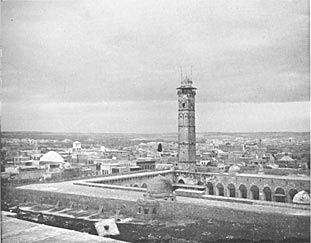
|
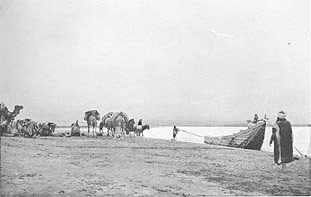
|
[ Illustrations opposite p.27 ]

|
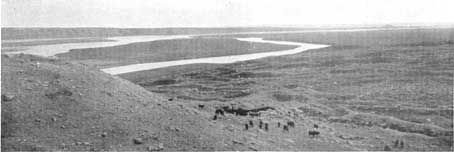
|
/ TELL AHMAR p.27 / Sajûr valley, which we reached
near Chat. We had left the carriage track and now followed the windings of the
Sajûr by a path narrow at best and none the better for the recent rains. A man
on a donkey jogged along behind us, and I caught fragments of his
conversation with Hâjj 'Alî. He asked the meaning of the word hurrîyeh (liberty),
a question to which he received no very definite answer. He did not press the
point, but remarked that for his part he knew nothing of the new government, but
this he knew, that no one in these villages had done military service (I suppose
on account of the exemption that was extended to all who dwelt upon the Sultan's
domains) and no one was written down " 'and el hukûmeh" (on the official
register). He prayed God that this fortunate estate might not suffer change. In
three hours from Manbij we reached Osherîyeh, turned a bit of rising ground and
came in sight of the Euphrates, flowing beneath white cliffs. If I had been
instructed in the proper ceremonies I should have wished to offer up a sacrifice
or raise a bethel stone, but failing these I paid the only tribute that can be
accorded in an ungracious age and photographed it. Hâjj 'Alî drew bridle and
watched the proceeding.
"I see it for the first time," said I apologetically.
"Eh yes," he replied, "this is our Euphrates," and he turned
an indulgent eye upon the rolling waters that are charged with the history of the ancient world.
The path dropped down into the valley and ran under cliffs
which are honeycombed with chambered caves, made, or at least deepened, by the
hand of man. The water was low at this season, and where we joined the river it
was divided into two arms by a long island. Half-an-hour further down the arms
met, and lower still another little island, which is covered after the snows
begin to melt in the northen mountains, was set in the wide stream. Here was the
ferry (Fig. 15). A company of bedraggled camels and camel-drivers waited on the
sands while the cumbrous boats were dragged up from the point to which they had
been washed by the current. The ferrymen had been weatherbound at Tell Ahmar,
and the caravans had spent a weary two days by the river's edge. / p.28 / They had eaten misery, sighed the camel-drivers; wallah, no
bread they had had, no fire and no tobacco; but with the patient deference of
the East they stood aside when the first boat came lumbering up and observed
that the Consul Effendi had best cross while the air was still. We drove our
horses into the ferry boat, and by a most unnautical process, connected with
long poles, our craft was run ashore upon the island, over which we ploughed our
way and found a second boat ready to take us across the smaller channel. We
landed in Mesopotamia at the village of Tell Ahmar, which takes its name from
the high mound, washed by Euphrates, under which it lies (Fig. 16). Jûsef spread
out my lunch on the top of the tell, and we watched the caravan embark from the
opposite bank and were well pleased to have accomplished the momentous passage
in good order, with all our eagles pointing the right way.
I lingered on the
mound, making acquaintance with a world which was new to me, but immeasurably
old to fame. The beautiful empty desert stretched away east and north and south,
bathed in the soft splendour of the February sun, long gentle slopes and low
bare hills, and the noble curves of the Euphrates bordering the waste. Near the
river and scattered over the first two or three miles of country to the east of
it, there are a number of isolated mounds which represent the site of very
ancient settlements.1
---------------------------
1 A few of these may have preserved a certain importance in a later age: Tell el Ghânah, directly to the east of Tell Ahmar, has been conjectured to be Thilaticomum (possibly incorrectly: Regling, Beiträge zur alten Geschichte, 1902, Vol. I. p. 474) and Tell Bada'ah to be Aniana, the first being mentioned in the Antonine Itinerary and the second by Ptolemy.
---------------------------
Of these Tell Ahmar is by far the most important. The ridge of silted earth which marks the line of the walls encloses three sides of a parallellogram, the river itself defending the fourth side. Strewn about the village are several stone slabs carved in relief with Hittite figures; outside one of the gates in the east wall are the broken remains of a Hittite stela, and before the second more southerly gate lie two roughly carved lions with inscrip- / TELL AHAMRA p.29 / tions of Shalmaneser II.1
---------------------------
1 Mr. Hogarth (at whose request I visited Tell Ahmar) has published the carved slabs and the stela in the
Annals of Archaeology and Anthropology, Vol. II. No. 4. he saw them when
he was at Tell Ahmar in 1908.
---------------------------
By the time I had finished lunch Hâjj 'Alî had selected a villager to serve
me as guide to the wonders of Tell Ahmar, and we set off together to inspect the
written stones. My new friend's name was Ibrahîm. As we ran down to
Shalmaneser's lions he confided to me that for some reason, wholly concealed
from him, wallah, he was not beloved of the Kâimmakâm of Bumbuj, and added that
he proposed to place himself under my protection, please God.
"Please God,"
said I, wondering to what misdeeds I might, in the name of my vassal, stand
committed.
The fragments of the Hittite stela were half buried in the ground,
and I set Ibrahîm to the village, bidding him collect men with picks and spades
to dig them out. The monument had been a four-sided block of stone with rounded
corners, covered on three sides with an inscription and on the fourth with a king
in low relief standing upon a bull (Fig. 18). When we had disengaged the bull
from the earth the villagers fell to discussing what kind of animal it was, and
Ibrahîm took upon himself to pronounce it a pig. But Hâjj 'Alî, who had been
tempted forth from the tents to view the antîca, intervened decisively in the
debate.
"In the ancient days," said he, "they made pictures of men and
maidens, lions, horses, bull and dogs; but they never made pictures of
pigs."
This statement was received deferentially by all, and Ibrahîm, with
the fervour of the newly convinced, hastened to corroborate it.
"No, wallah! They never made pictures of pigs."
The whole village turned out to help in
the work of making moulds of the inscriptions, those who were not actively
employed with brush and paste and paper sitting round in an attentive circle.
There is little doing at Tell Ahmar, and even the moulding of a Hittite
inscription, which is not to the European an occupation fraught with interest,
affords a wel- / p.30 / come diversion — to say nothing of the
prospect of earning a piastre if you wait long enough. But on the third day,
wind and rain called a halt, and guided by the sheikh of the neighbouring
village of Kubbeh I explored the river-bank. Half-an-hour below Tell Ahmar, among
some insignificant ruins, we found a small Hittite inscription cut on a bit of
basalt, and close to it a block of limestone carved with a much effaced relief.
A few minutes further to the east a lion's head roughly worked in basalt lay
upon a mound. The head is carved in the round, but we dug into the mound and
uncovered a large block on which the legs were represented in relief. We rode on
to Kubbeh, where the inhabitants are Arabic-speaking Kurds, and found in the
graveyard the fragment of a Latin inscription in well-cut letters--
| C | O | M | F |
| L | O | N | G |
| H | F | R | |
| V | I | A | S |
[ Illustrations opposite p.30 ]
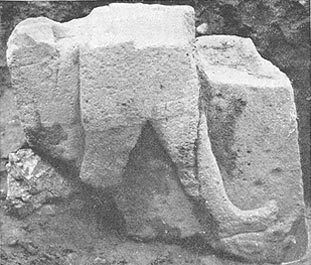 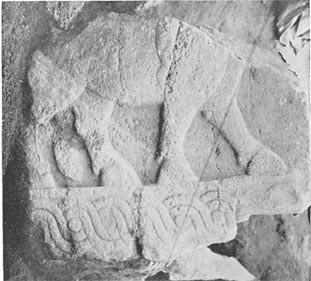
|
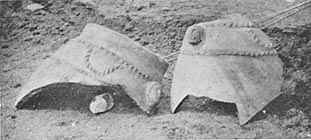
|
[ Illustrations opposite p.31 ]
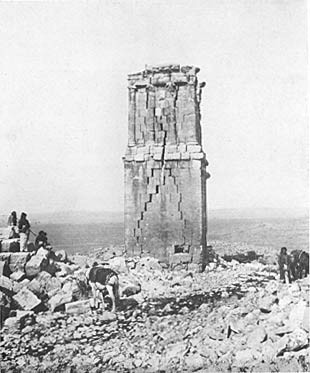
|
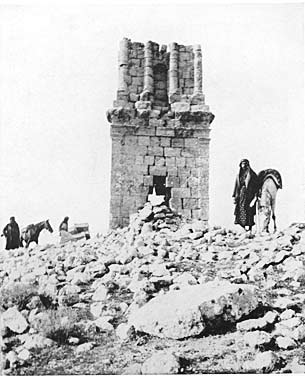
|
/ CARCHEMISH p.31 / camp Ibrahîm brought me two fragments of a large earthenware jar decorated round the
top with a double line raised and notched in the clay (Fig. 19). In the band
between were set alternately a head in high relief and a semi-circle of the
notched clay. The heads were finely worked, the eyes rather prominent and the
cheeks round and full — a type which recalled that of the stone heads carved
upon the walls of the Parthian palace at Hatra. Whether it were Parthian or not,
the jar was certainly pre-Mohammadan.
The night closed in cloudless and
frosty, and I resolved to risk the caprices of the river and ride up next
morning to Carchemish, for it is impossible to lie within half-a-day's journey
of a great capital and yet make no effort to see it. Before dawn we sent a
messenger up the river and charged him to bring us a boat to a point above the
camp, that we might land on the west bank of the Euphrates above its junction
with the Sajûr, a river which we were told was difficult to cross. In
half-an-hour Fattûh and I reached Tell el 'Abr (the Mound of the Ford), where
there is a small village, and on going down to the river found, to our surprise,
that the boat was there before us — but not ready; that would have been too
much to expect. I left Fattûh to bale out the water with which it was filled and
went off to inspect Tell el Kumluk, a quarter of an hour away if you gallop.
Here there was no village, but only a large graveyard with broken columns used
as tombstones. By the time I returned to the river the boat had been made more
or less seaworthy, but a sharp little wind had risen, the swift current of the
Euphrates was ruffled, and the boatmen shook their heads and doubted whether
they would dare to cross. We did not leave the decision to them, but hurried the
horses into the leaking craft and pushed off. The stream swept us down and the
wind held us close to the east bank, but with much labour and frequent
invocation of God and the Prophet we sidled across and ran aground on the
opposite shore. Our troubles were not yet over, for our landing-place turned out
to be a big island, and there was still an arm of the river before us. The
stream had risen during the rain of the previous day and was racing / p.32 / angrily through the second channel, but we plunged in and,
with the water swirling round the shoulders of our horses, succeeded in making
the passage. We shook ourselves dry and turned our faces to Carchemish. The road
under the bluffs by the river-side was impassable, and we climbed up a gorge
into the rocky country that lies along the top of the cliff. At one point we saw
a mass of ruins, door-jambs and squared stones, which Kiepert — I know not on
what ground — calls Kloster Ruine. In that bare land we met a cheerful old man
driving a donkey and carrying a rifle. "Whither going in peace?" said he. "To
Carchemish," we answered (only we called it Jerâblus), and I fell to considering
how often the same question had met with the same answer when the stony path was
full of people from the Tell Ahmar city going up and down to learn the news of
the capital and bring back word of the movements of Assyrian armies and the
market price of corn. Fattûh, elated by the conquest of the river, bubbled over
with talk, simple tales of his beloved Aleppo, of the ways of its inhabitants
great and small, and of his many journeys to Killîz and 'Ain Tâb, Urfah,
Diyârbekr, and Baghdâd.
"Your Excellency knows that I was the first man to
take a carriage to Baghdâd, for there was no road then, but afterwards they made
it. And as for my carriage, Zekîyeh has lined it inside and filled it with
cushions, so that the gentry may lie at ease while I drive them. And have I told
you how I got Zekîyeh?"
"No," said I mendaciously; I have travelled with
Fattûh before, and have not been left unaware of the episodes that led to his
betrothal, but reminiscences that take the listener into the heart of Eastern
life bear repetition. The lady of Fattûh's choice was fourteen when he first set
eyes on her; he went straight to her father and made a bid for her hand, but the
girl was very fair and the father asked a larger dowry than Fattûh could give. "Fortunately," continued Fattuh ingenuously, "he had an illness of the eyes, and
I said to him: 'There is in Aleppo a doctor who loves me, and will cure you for
my sake.' But he answered: 'God give you / CARCHEMISH p.33 / wisdom! none can cure me save only God.' And I mounted him in my carriage,
and drove him to that doctor, and look you, he healed him so that he saw like a
youth. Then he said, 'There is none like Fattûh, and I will give him my daughter
even without a dowry.' So I bought her clothes and a gold chain and all that she
desired, for I said, 'She shall have nought but what I give her.' And since we
married I have given her gold ornaments and dresses of silk, and when we return
from this journey I will take her on a pilgrimage to Jerusalem. And indeed she
loves me mightily, and I her," said Fattûh, bringing his idyll to a satisfactory
conclusion. I have seen Zekîyeh in all the bravery of her silk gowns and gold
ornaments, and I do not think she has ever had cause to regret the day when
Fattûh mounted her father in his carriage.
We rode fast, and in a couple of
hours came down to the Euphrates again, and so over the low ground for another
hour till we reached a tell by the river with a village close to it. This
village and tell, as well as the large mound half-an-hour away to the
north-west, and the farm near it, are all called Jerâblus,1
---------------------------
1 Jerâblus or Jerâbîs, the names
are used indiscriminately. The former is thought by Nöldeke to be an Arabic
plural of Jirbâs (mentioned by Yâkût as opposite Kinnesrin, Dictionary, Vol. II.
p. 688) and the latter as Arabicized from
Europus.
---------------------------
and probably local tradition is right in drawing no distinction between the widely
separated mounds, the whole area between them having been, in all likelihood,
occupied by the houses and gardens of the Hittite capital. Until you come to Babylon there is no site on the Euphrates so imposing as
the northern mound of Carchemish (Fig. 17). It was the acropolis, the strongly
fortified dwelling-place of king and god. At its north-eastern end it rises to a
high ridge enclosed on two sides in a majestic sweep of the river. From the top
of this ridge you may see the middle parts of the strategic line drawn by the
Euphrates from Samosata to Thapsacus, strung with battlefields whereon the
claims of Europe and Asia were fought out; while to the west stretch the rich
plains that gave wealth to Carchemish, to Europus, / p.34 / and to
Hierapolis. They are now coming back into cultivation as the merchants of Aleppo
acquire and till them, or enter into an agricultural partnership with their Arab
proprietors, and if the Baghdâd railway is brought this way, as was confidently
expected, the returns from them will be doubled or trebled in value. The
northern mound is covered with the ruins of the Roman and Byzantine city,
columns and moulded bases, foundations of walls set round paved courtyards, and
the line of a colonnaded street running across the ruin field from the high
ridge to a breach that indicates the place of a gate in the southern face of the
enclosing wall. A couple of carved Hittite slabs, uncovered during Henderson's
excavations and left exposed at the mercy of the weather, bear witness to the
antiquity of the site. It has long been desolate, but there is no mistaking the
greatness of the city that was protected by that splendid mound.
Fattûh had
ordered the boatmen to pull or punt the boat over to the west bank during our
absence; the river was rising and the arm that we had crossed with difficulty in
the morning might have been impassable by nightfall. The boat was surrounded
when we arrived by every one in the district who happened to have business on
the opposite bank, and recognized in our passage an unusually favourable
opportunity for getting over for nothing. As soon as we had embarked, some
twenty persons and four donkeys hustled in after us and were like to swamp us,
but Fattûh rose up in anger and ejected half of them, pitching the lean and
slender Arab peasants over the gunwales and into the water at haphazard until we
judged the boat to be sufficiently lightened. Those who were allowed to remain
earned their passage, for when we presently ran aground on the head of the
island — as it was obvious to the most inexperienced eye that we must — they
leapt out and wading waist high in the stream, pushed us off. So we galloped
home beside the swiftly-flowing river, aglint with the sunset, and found the
camp fire lighted and the cooking pots a-simmer, and Tell Ahmar settling down to
its evening meal and to rest.